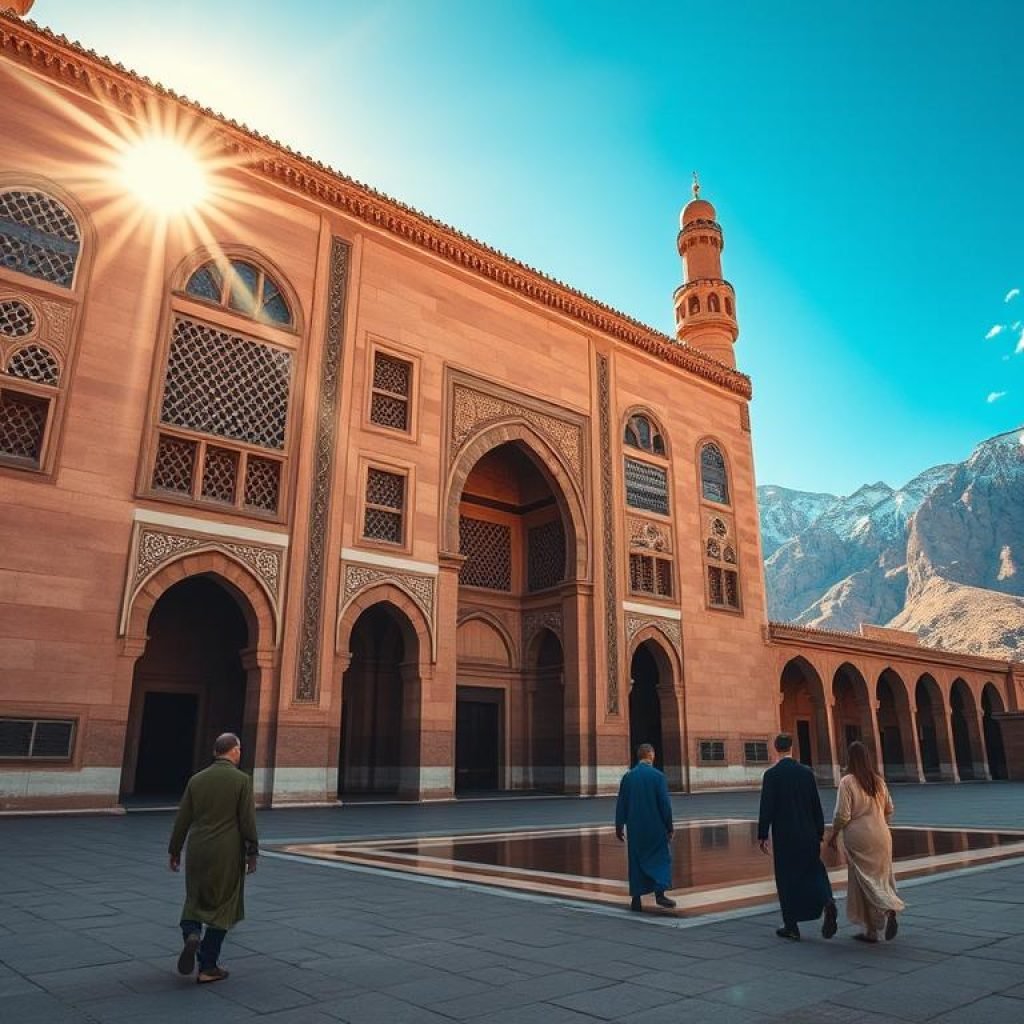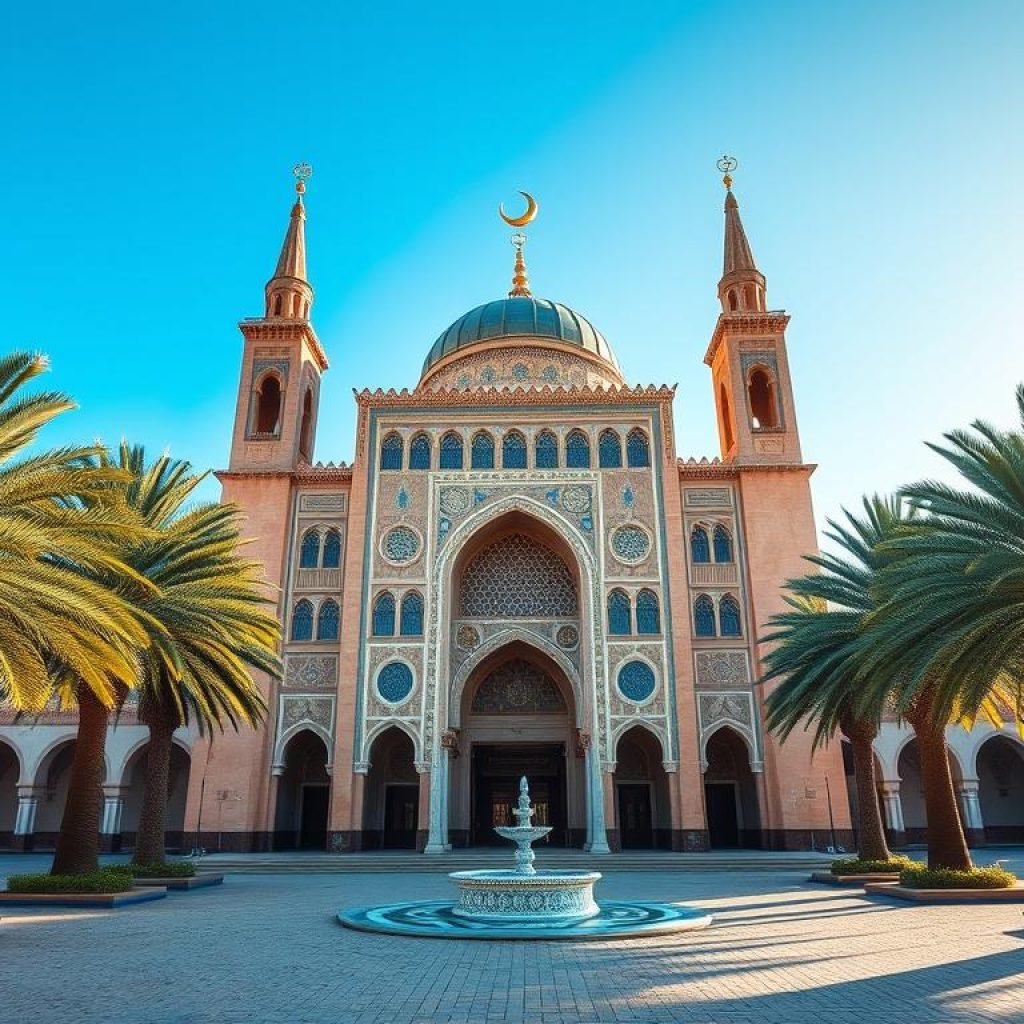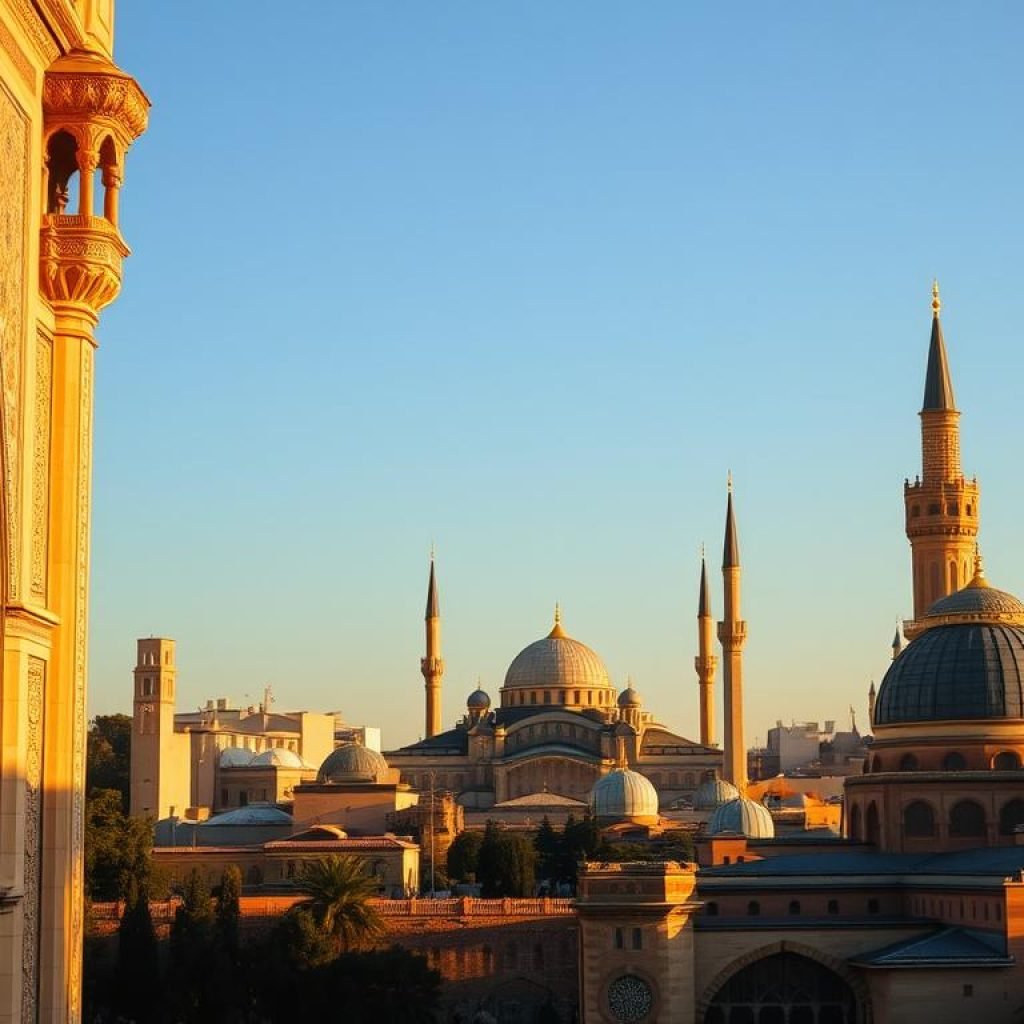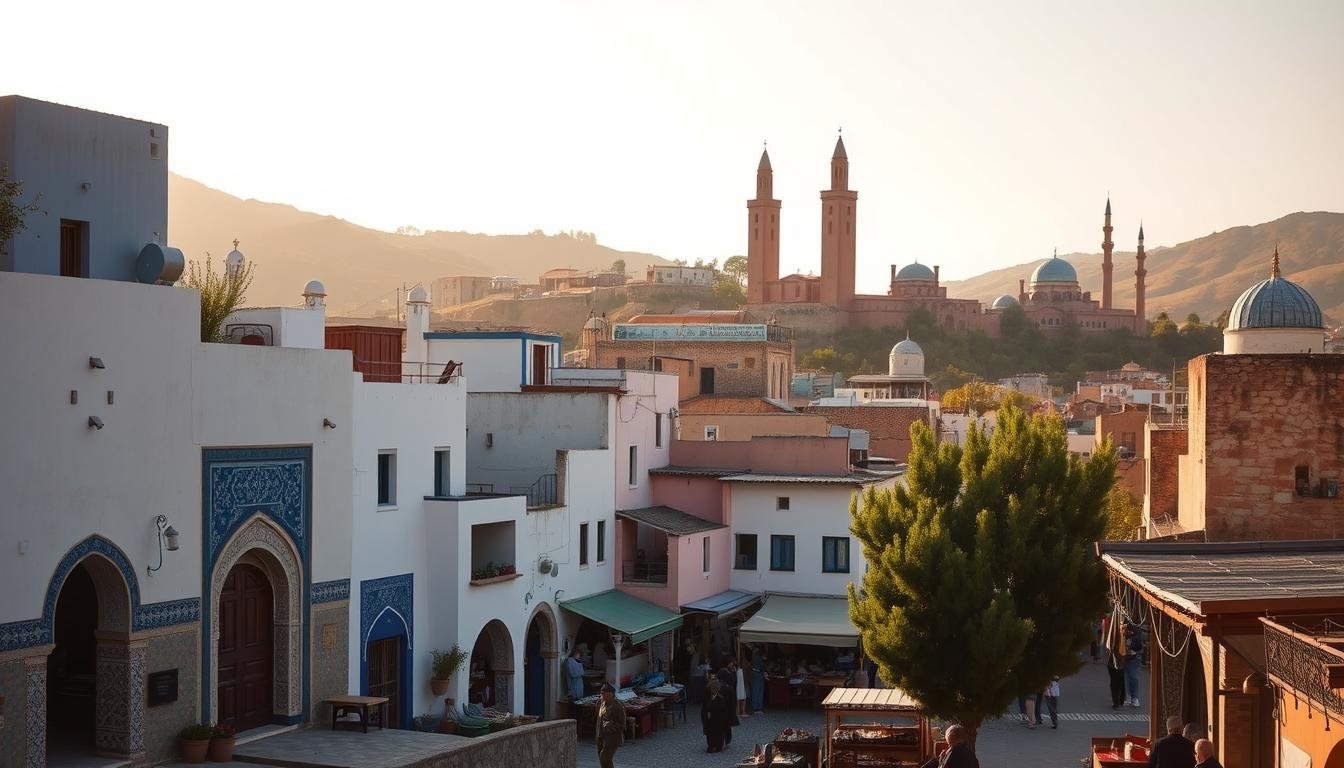Morocco is filled with historical mosques, each with its own special architecture and cultural importance. These mosques show the country’s rich history and traditions. Places like the Al-Qarawiyyin Mosque are among the oldest and most significant in the world.
The Hassan II Mosque is another example of Morocco’s Islamic architecture and cultural history. When you visit Morocco, don’t miss out on seeing these mosques. They are a blend of Islamic architecture and cultural history.
The Hassan II Mosque and the Koutoubia Mosque are must-sees. They have stunning tile work, tall minarets, and beautiful courtyards. The Medina of Moulay Idriss Zerhoun is also a UNESCO World Heritage Site. It has traditional Moroccan Hammams and the Idriss Medersa, a 17th-century Quranic school.
Key Takeaways
- Explore the grandeur of Morocco’s top historical mosques, including the Hassan II Mosque and the Koutoubia Mosque.
- Visit the Medina of Moulay Idriss Zerhoun, a UNESCO World Heritage Site, and discover its traditional Moroccan Hammams and the Idriss Medersa.
- Learn about the history and cultural significance of Moroccan mosques, including the Al-Qarawiyyin Mosque and the Al-Attarine Madrasa.
- Discover the unique architecture and cultural heritage of Morocco’s historical mosques, including their intricate tile work and soaring minarets.
- Plan your visit to Morocco’s historical mosques, including the best times to visit and what to expect.
Introduction to Moroccan Mosques
Moroccan mosques are famous for their beautiful Islamic architecture. They mix old and new styles. The Al Qaraouine Mosque, built in 859 by Fatima El Fihria, is a key example of Morocco’s rich culture.
These mosques have a minaret, domes, high ceilings, a mihrab, and an open courtyard. Zellij, a mosaic tilework, is a special feature of Moroccan mosques. The Al Qaraouine and Al Bouanania mosques are known for their detailed tile work and ornate designs.
- Square-shaped minarets, contrasting with the cylindrical minarets found in other Muslim countries
- Pyramid-shaped exteriors adorned with green bricks
- Intricately decorated interiors, featuring zellij, wood, plaster, brass, stone, marble, wrought iron, and green bricks
The Hassan II Mosque in Casablanca is a famous landmark. It shows Morocco’s mix of old and new Islamic architecture. The Old mosques in Morocco, with their history and beauty, amaze people from all over the world.
Hassan II Mosque
The Hassan II Mosque is a famous mosque in Morocco, known for its stunning architecture and historical significance. It is located in Casablanca, a key example of Morocco religious landmarks. The mosque’s design features marble, granite, and glass, along with intricate tile work and ornate plasterwork.
As a Famous mosques Morocco, the Hassan II Mosque draws visitors from all over. Its construction started in 1986 and finished in 1993, taking 7 years. The mosque can hold up to 105,000 people, with the prayer hall for 25,000 and the esplanade for 80,000.
To learn more about Morocco’s history and culture, visit Meknes, one of the country’s four imperial cities. The Hassan II Mosque is a must-see for those interested in Morocco religious landmarks and Famous mosques Morocco.

Architecture and Design
The mosque’s architecture combines modern and traditional styles. It has a retractable roof, allowing worshippers to see the stars at night. The minaret stands at 210 meters, the tallest in Morocco and the world.
Historical Significance
The Hassan II Mosque was designed by French architect Michel Pinseau and built by Bouygues. The mosque uses materials almost entirely from Morocco, except for white granite columns and glass chandeliers from Murano, Italy.
Koutoubia Mosque
The Koutoubia Mosque is a key historical mosque in Morocco, highlighting the country’s rich culture. It’s in Marrakech, one of the oldest and most historic mosques in Morocco. Built in the 12th century, it shows a mix of Almohad and Marinid architectural styles.
Its design includes arches, domes, and minarets, along with detailed tile work and plasterwork. The mosque’s minaret is 77 meters tall, making it a city landmark. It’s not just a historical site but also a center of Islamic learning, active since the 12th century.
The mosque’s history spans two major construction phases. The first started in 1147, and the second in 1154. It was finished between 1158 and 1195. Since 1985, it’s been a UNESCO World Heritage Site, showing its cultural and historical value.
Some key features of the Koutoubia Mosque include:
- A prayer hall measuring 90 meters wide and ranging from 57 to 66 meters in length
- 112 columns supporting horseshoe arches
- 17 parallel naves
- A minaret with a square base measuring 12.81 meters per side
The Koutoubia Mosque is a symbol of Morocco’s rich cultural heritage. Its historical importance is clear. As a key Historical mosque in Morocco, it remains a vital part of the country’s culture.
Tinmal Mosque
The Tinmal Mosque is in the High Atlas Mountains of Morocco. It’s a historic mosque that mixes Almohad and Marinid styles. Built in 1148 CE, it honors Ibn Tumart, the Almohad founder. Its minaret wraps around the mihrab, unlike most mosques.
This old mosque in Morocco is very important. It has been restored several times, including a big one in the 1990s. Sadly, the 2023 earthquake damaged it a lot, with 75% destroyed. Now, a 18-month restoration is underway to save it.
Travelers should see the Tinmal Mosque to understand Morocco’s culture and history. For more on Moroccan mosques, check out Moroccan bathroom tips. It shows how these mosques mix old craftsmanship with new comforts.
Some key features of the Tinmal Mosque include:
- 7 entrances, with 3 on the east side, 3 on the west side, and 1 central entrance to the north
- A floor plan of approximately 43 by 40 meters
- 9 naves in the main prayer hall
- 3 muqarnas cupolas in the southern aisle of the qibla wall

Bou Inania Madrasa
The Bou Inania Madrasa is a key example of Islamic architecture in Morocco. It shows the country’s rich cultural heritage. Located in Fez, this madrasa is a major monument of the Marinid dynasty.
It combines Marinid and Saadian architectural styles. The madrasa is known for its intricate tile work, ornate plasterwork, and beautiful wood carvings.
As a Morocco historical site, the Bou Inania Madrasa is a must-see. It has arches, domes, and minarets, giving it a grand and elegant look. The main courtyard is rectangular, with a central fountain and basin for ablutions.
Some of the key features of the Bou Inania Madrasa include:
- Two entrances, one on Tala’a Kebira street and another on Tala’a Seghira
- A prayer hall divided by a transverse row of arches resting on marble and onyx columns
- A minaret located at the northwestern corner of the madrasa, one of the few madrasas in Morocco to have a minaret
- A water clock, known as Dar al-Magana, which was completed on May 6, 1357, and features 13 intricately carved consoles
The Bou Inania Madrasa is not just a historical site but also a cultural landmark. It reflects Morocco’s rich heritage and architectural traditions. It continues to inspire wonder and awe in visitors, making it a must-see for anyone exploring Morocco’s historical sites.
Sidi Bou Abib Mosque
The Sidi Bou Abib Mosque is a standout among Famous mosques Morocco. It beautifully combines modern and traditional designs. Situated in Tangier, Morocco, this mosque was constructed in 1917. It boasts stunning features like marble, granite, and glass, along with detailed tile and plasterwork.
As a key Morocco religious landmark, the Sidi Bou Abib Mosque holds deep cultural and historical value. Its vibrant tiles and exquisite architecture draw visitors globally. The mosque’s design mirrors Morocco’s rich cultural heritage, showcasing the country’s varied influences and traditions.
Here are some key facts about the Sidi Bou Abib Mosque:
- Year of establishment: 1917
- Location: Tangier, Morocco
- Architectural style: Blend of modern and traditional styles
- Notable features: Polychrome tiles, marble, granite, and glass

The Sidi Bou Abib Mosque is a vital part of Morocco’s cultural tapestry. Its beauty and importance make it a top spot for those interested in Famous mosques Morocco and Morocco religious landmarks.
Grand Mosque of Taza
The Grand Mosque of Taza is a key Morocco historical site. It shows the country’s deep cultural roots. Located in Taza, it mixes Almohad and Marinid styles beautifully.
The mosque’s story began in the 12th century. It was first about 32 by 33 meters. Later, it grew, adding two side naves during the Marinid era. Now, it’s about 72 by 44 meters, with nine gates.
The mosque’s centerpiece is a massive chandelier. It’s the oldest and largest in the world, weighing 3000 kilograms. It stands four meters tall and two and a half meters wide. It has 500 chalices. The mosque also has a library with 907 original manuscripts and books.
The Grand Mosque of Taza has always been a place for prayer and learning. Its importance is marked by a 1294-1295 inscription. It’s a treasure trove of knowledge, making it a top Historical mosques in Morocco.
Conclusion
Morocco mosques showcase the country’s rich culture and diverse architecture. Islamic architecture Morocco is a big part of its identity. The Hassan II Mosque and the Koutoubia Mosque are just a few examples of why Morocco mosques attract tourists and locals alike.
The future of Morocco mosques is bright. The Moroccan government is working hard to keep these historic sites alive. They have started many projects to help. These include:
- Restoring old mosques
- Building new mosques with modern designs
- Encouraging tourism to see Morocco mosques
- Supporting local artisans in preserving Islamic architecture Morocco
As Morocco grows and changes, its mosques will stay a key part of its culture. With their history, beauty, and lively culture, Morocco mosques are a must-see for anyone interested in Islamic architecture Morocco.

Final Thoughts
Morocco’s mosques are more than just places of worship. They are symbols of the country’s history and culture. The government and local communities have worked hard to keep these sites in good shape. But, there’s still a lot of work to do to protect them.
These historical sites, like the famous mosques, show what makes Morocco unique. They tell the story of the country’s past, influenced by many cultures. From the simple Berber buildings to the huge Hassan II Mosque, they show Morocco’s strength and creativity.
It’s important to keep these mosques safe. They help us understand and value Morocco’s history. By protecting them, we make sure future generations can see the amazing work and stories behind Morocco’s buildings.




Comment (0)